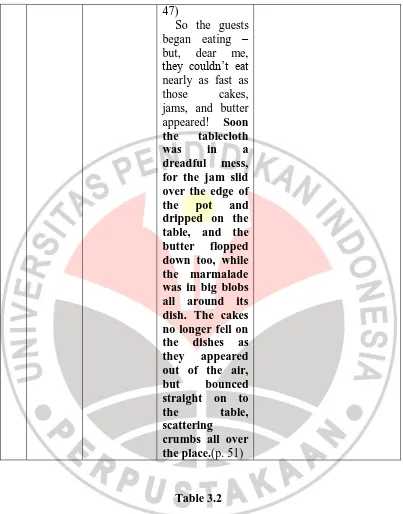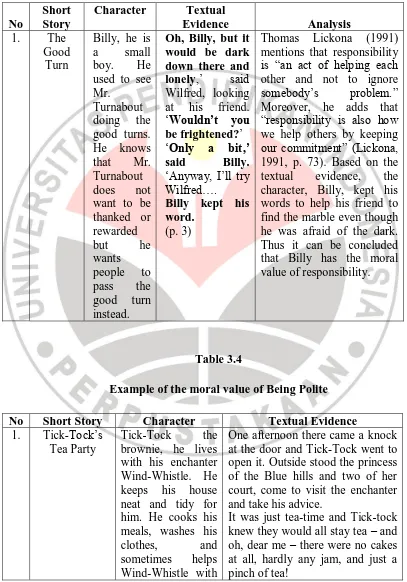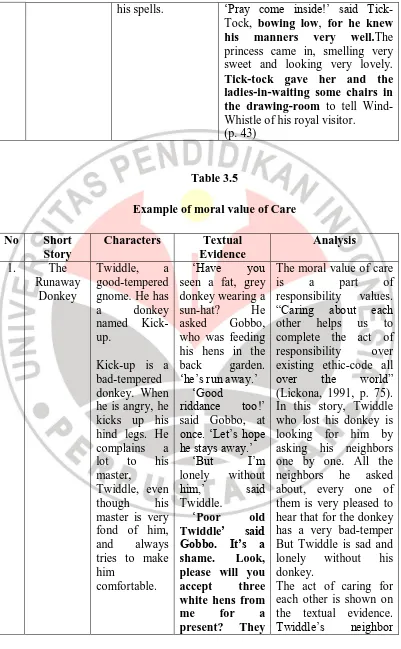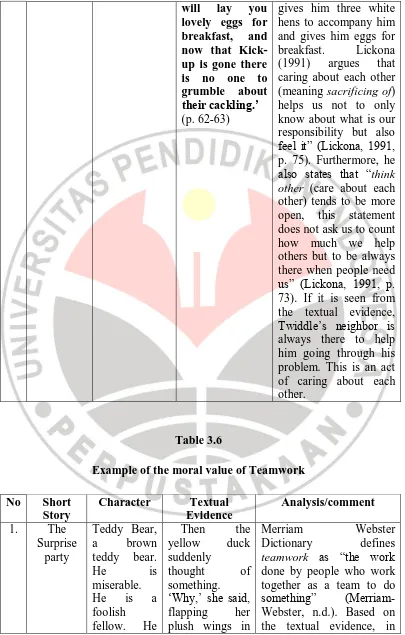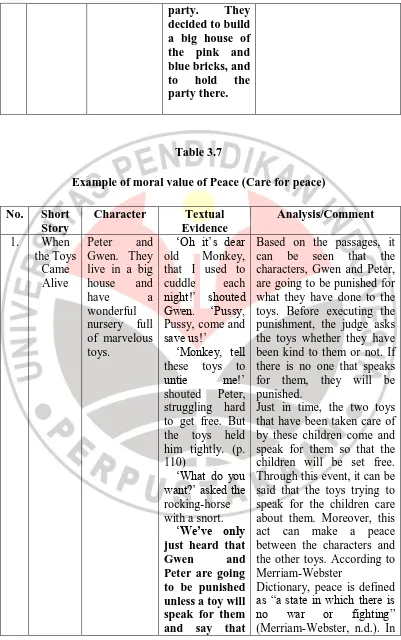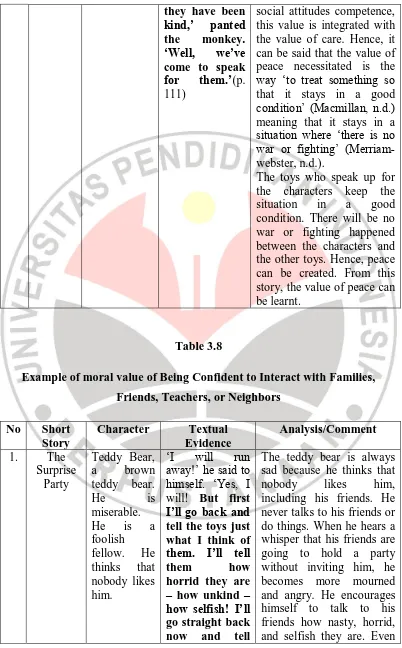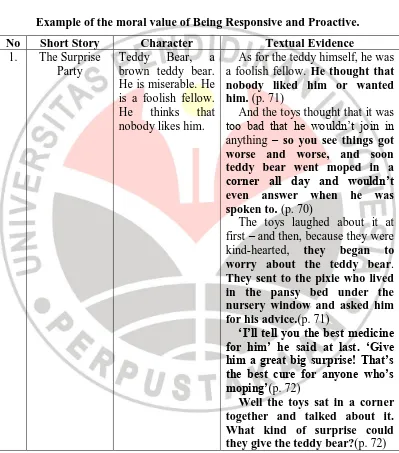Promoting Character Education: An Analysis of Moral
Values Embodied in Children’s Book
Eight O’clock Tales
by Enid Blyton
A Research Paper
(Submitted to the English Education Department of the Faculty of Language and Arts Education of the Indonesia University of Education as Partial Fulfillment
Requirements for Sarjana Pendidikan degree)
By
Velentina Rizki Sutari
0900665
English Education Department
Faculty of Language and Arts Education
Indonesia University of Education
TABLE OF CONTENTS
STATEMENT OF AUTHORIZATION ... i
PREFACE ... ii
ACKNOWLEDGEMENT ... iii
ABSTRACT ... v
TABLE OF CONTENTS ...vi
LIST OF TABLES ... ix
CHAPTER I INTRODUCTION ... 1
1.1. Background of Study ... 1
1.2. Research Question ... 3
1.3. Aim of the Study ... 3
1.4. Scope of the Study ... 3
1.5. Significance of the Study ... 3
1.6. Research Methodology ... 4
1.6.1. Data Collection ... 5
1.6.2. Data Analysis ... 5
1.7. Clarification of Terms ... 6
CHAPTERII
LITERATURE REVIEW ... 8
2.1. Children’s Literature ... 8
2.2. Character Education ... 12
2.2.1. Previous Studies ... 15
2.3. Moral Values ... 17
2.4. Moral Values Mentioned in 2013 Curriculum ... 19
2.4.1. Honesty ... 19
2.4.2. Discipline ... 20
2.4.3. Responsibility ... 20
2.4.4. Being Polite ... 20
2.4.5. Care ... 21
2.4.6. Teamwork ... 21
2.4.7. Peace (Care for the peace) ... 21
2.4.8. Being Confident to Interact with Families, Friends, Teachers, and Neighbors ... 22
2.4.9. Being Responsive and Proactive ... 22
2.4.10. Tolerance ... 22
2.4.11. Patriotism ... 23
CHAPTER III
RESEARCH METHODOLOGY ... 28
3.1. The Object of the Study ... 28
3.2. Research Question ... 28
3.3. Research Methodology ... 29
3.4. Research Procedures ... 29
3.5. Data Source ... 30
3.6. Data Presentation ... 30
CHAPTER IV FINDINGS AND DISCUSSION ... 42
4.1. Moral values embodied in the Children’s Book Eight O’clock Tales by Enid Blyton ... 42
4.1.1. Honesty ... 42
4.1.2. Discipline ... 44
4.1.3. Responsibility ... 46
4.1.4 Being Polite ... 50
4.1.5. Care ...52
4.1.6. Teamwork ... 54
4.1.7. Peace (Care for the peace) ... 54
Neighbors ... 56
4.1.9. Being Responsive and Proactive ... 57
4.2. Discussion ... 59
CHAPTER V THE CONCLUSIONS AND SUGGESTIONS ... 64
5.1. The Conclusions ... 64
5.2. Suggestions ... 65
REFERENCES ... 66
CHAPTER I
INTRODUCTION
This chapter provides the nature of the present study. It covers the
background of the study, the research question, the aim of the study, the
significance of the study, the research methodology, the subject of research, the
data analysis, the clarification of terms, and the organization of the paper.
1.1.
Background of the Study
The Macmillan English Dictionary defines literature as “stories, poems,
and plays, especially those that are considered to have value as art and not just
entertainment” (Macmillan Publisher Ltd. 2003). Children’s stories contain uses
of language that are typically considered poetic. Many of children’s stories
devices offer opportunities for foreign language learning (Cameron, 2001, p. 163).
In line with Cameron,Collie, and Slater also suggest that “short stories are often an
ideal way of introducing students to literature in the foreignlanguage classroom”
(Collie & Slater, 1987 p. 167). Since English is taught in Indonesia as aforeign
language, stories are believed to be useful as an educationalmaterial.This is
confirmed by Cameron (2001, p. 160) who states “many of the text in books
found in schools are not poetic, meaningful stories that will instantly capture
children’s imagination”.
Nodelman(2008, p. 157) states that “children’s literature is primarily
didactic literature”.The aim of literature is “to teach and to delight”(Peck and
Coyle, 2002, p. 152). Moreover Lazar also states that “literary texts have a
powerful function in raising moral and ethical concernsin the classroom” (Lazar,
1993, p. 18).Thus, the idea of children’s literature as a didactic literature or
“literature of education” seems to be the root of the function or the aim of
literature in general (Nodelman, 2008).
Since children’s literature functions as didactic literature, it most likely
charactereducation in Indonesia becausemoral values are often associated with
character education. Theodore Roosevelt once said that “to educate a person in the
mind but not in morals is to educate a menace to society” (Roosevelt, (n.d.) cited
in Lickona, 1991, p. 3). Ministry of Education and Culture, Muh. Nuh also stated
in National Education day 2010that “character education is the key to resolve the
entire crisis that this country has been suffering from” (Nuh, 2010).It shows how
important moral values to be taught in education system. However, it should be
noted that the values and attitude embodied in literary text given to the students
should be acceptable since Cameron argues that “stories should be checked for
values and attitude because they may not be appropriate” (Cameron, 2001, p.
168).
Some people believe that young people lack of values, hence they should
be taught through didactic literature (Stoodt, 1996, p. 218). However, it is not how
the values are espoused but how they are presented in the stories (ibid.). Stoodt
also suggests that the best written one is how the values and beliefs are presented
implicitly (ibid.). In line with Stoodt, Susan Sharp (1992) states that
“It is the values and ideas we think children might miss if
we don’t assert them that lead us into didactic stories, however, in the works of the greatest writers, unresolved
issues can make the best stories” (Sharp in Stoodt, 1996, p. 218).
Based on the statement in 2013 Indonesia curriculum, “national education
as one of national development sectors has a vision of realizing education system
as a strong and dignified social institution in order to empower Indonesian people
to be qualified” (Kurikulum, 2013).This means, according to
Undang-UndangNomor 20 tahun 2003 about National Education System, educated man
who has faith and fear of God;who is noble, healthy, knowledgeable, skilled,
creative, independent, becomes a democratic and responsible citizen.
Consequently, national education must be functioned as the main vehicle in
optimally building Indonesian’s character. Therefore, “Eight O’clock Tales”
that the stories featured in the book contain moral values that are in line with what
is written in the Constitution.
1.2.
Research Question
This study tries to seek the answer to this question:What are the moral
values embodied in Enid Blyton’sEight O’clock Tales short stories?
1.3.
Aimof the Study
Based on research question, the aim of the study is to find out the moral
values embodied in Enid Blyton’s Eight O’clock Tales short stories.
1.4.
Scope of the Study
Thisstudy focuses on analyzing the moral values embodied in the short
stories of children’s book entitled “Eight O’clock Tales” by Enid Blyton.
1.5.
Significance of the Study
The proposed study is believed to have several significances for
theoretical, practical, and professional benefits.
1) Theoretical benefit
The findings of the study can be used as contribution towards the study about
moral values and its role for students’ character education development.
2) Practical benefit
The findings also can be useful for teachers, students, and the readers who are
interested in children’s literature which most likely containsmoral values. For
the students, Lazar (1993) states that literature should be used with students
because:
– it is very motivating
– it is authentic material
– it is found in many syllabuses
– it helps students to understand another culture
– it is a stimulus for language acquisition
– it develops students’ interpretative abilities
– students enjoy it and it is fun
– it is highly valued and has a high status
– it expands students’ language awareness
– it encourages students to talk about their opinions and feelings (Lazar, 1993, p. 18)
For the teachers, it will enrichEnglish teaching material in any school level
since the language used is quite simple and easy. Thus it is expected to be an
alternative teaching material for the educators and practitioners. Moreover, the
new curriculum in Indonesia necessitates the educators to include the values in
every teaching material on the syllabus.
3) Professional benefit.
The findings of the study can improve the quality of the teacher-student
relationship, give contribution towards the classroom environment, encourage
the teacher and students to create and develop new ideas.
1.6.
Research Methodology
The study is descriptive in nature andemploysa textual analysis
framework. The study analyzes the moral values embodied in the children’s book
Eight O’clock Tales by Enid Blyton(2008) to promote character education in schools.This approach is preferred due to the textual form of the object of the
1.6.1. Data Collection
The primary data for the proposed study is in the form of short
stories compilation in children’s book Eight O’Clock Tales(2008) written
by Enid Blyton. The data are selected to answer the research question
because the stories featured in the books are assumed to have moral
values.This is related to character education that is being taken into
account in the 2013 Indonesia curriculum. Consequently, the data are
coupled with the secondary source i.e. 2013 curriculum.
1.6.2. Data Analysis
In conducting the research the following steps have been taken as
follow:
1. Reading carefully throughout the children’s book multiple times in
order to understand and to unearth the moral values embodied in Eight O’clock Tales by Enid Blyton (2008).
2. Highlighting the textual evidences related to the moral values
necessitated by social attitudes competence in 2013 Indonesia
curriculum.
3. Writing a brief note in the highlighted textual evidences in order to
simply identify how these values are suitable for student’s
character education.
4. Listing the textual evidences in the form of table based on the notes
so that the moral values embodied in the children’s book and its
relation to character education can be easily categorized for further
analysis.
5. Analyzing the textual evidences as well as presenting the data
framed within the related theories in order to answer the research
questions.
6. Discussing the findings of the research so that the conclusion can
1.7.
Clarification of Terms
The proposed study contains some terms that will cause
misunderstanding. Those terms are explained below:
1) Didactic (literary text): a work dealing with a moral or religious or
philosophical theme (Peck and Coyle, 2002).
2) Moral Values: honesty, responsibility, and justice are essential
things required in this life (Lickona, 2012, p. 61).
3) Literature: stories, poems, and plays, especially those that are
considered to have value as art and not just entertainment
(Macmillan English Dictionary).
4) Values: the beliefs people have about what is right and wrong and
what is most important in life, which control their behavior
(Cambridge Advance Learner’s Dictionary).
5) Tale: a story, especially one which might be invented or difficult to
believe (Cambridge Advance Learner’s Dictionary).
1.8.
Organization of Paper
This present study consists of five chapters as follows:
CHAPTER I
This chapter contains background of the study, research questions, aims of
the study, the scope of the study, significance of the study, research
methodology, and the organization of the paper.
CHAPTER II
It consists of details on the theoretical frameworks employed in the study.
This section contains the research methodology, describing the data used in
the research and the methodology to be adopted.
CHAPTER IV
This chapter presents the result found in relation to both the research
questions and existing knowledge.
CHAPTER V
This last chapter provides final reflection of the study and possible issue for
CHAPTER III
RESEARCH METHODOLOGY
This chapter presents the methodology of the study. This includes the
object of the study, research question, research methodology, technique of the
data analysis, source of the data, and data presentation.
3.1
The Object of the Study
This study attempts to analyze moral values embodied in children‟s book.
The object used in this study is a children‟s book entitled Eight O’clock
Tales,written by Enid Blyton and published in 2008.
Eight O’clock Tales is a fantasy fiction in which the characters are mostly animals and toys. Since it is a fantasy fiction, all of the stories involve magic. It
was first published in Great Britain in 1944. It features eleven short stories, they
are; The Good Turn, The Boy Who Heard Too Much, The Skittle Policeman,
Tick-Tock Tea’s Party, The Runaway Donkey, The Surprise Party, The Enchanted
Doll, When the Toys Came Alive, The Brownie who Pulled Faces, All the Way to
Toytown, and Poor Old Scarecrow!. Eight O’clock Tales is the last series of
O’clock Tales compilations.
This children‟s book is chosen because it is likely to have moral values embodied in the stories. It is, therefore, in line with theaim of this present study
that focuses on finding out the moral values and categorizing them based on 2013
curriculum.
3.2
Research Question
This study tries to seek the answer of the following question:
1. What are the moral values embodied in children‟s book Eight O’clock Tales
3.3
Research Methodology
S
ince the data used in this present studyare in the form of text, qualitativestudy which employs descriptive textual analysis is chosen. According to Hancock (2002), a research based on qualitative method “focuses on description and interpretation that may lead to development of new concepts or theory” in order to help people understand the subject of the study. By using qualitative
method which is supported by textual analysis, the collected data are identified in
order to meet the aim of the study. Moreover, Maxwell (1996) states that
qualitative study focuses on certain events not numbers, but more on words.
In addition, Alwasilahsuggests that there are four actions that the
researchers should fulfill: (1) establishing familiarity with the respondents, (2)
determining the sample, (3) collecting the data, and (4) analyzing the data
(Alwasilah, 2000, p. 100).
Textual analysis used in this qualitative study is defined as a technique to
gather the data (McKee, 2001). Textual analysis is used as the research technique
to identify the moral values embodied in the children‟s book Eight O’clock Tales
(2008) written by Enid Blyton. This technique is useful for researchers „who want
to understand the ways in which, in particular cultures at particular times, people make sense of the world around them‟ (ibid.)
3.4
Research Procedures
In conducting the present study, the following steps have been taken as
follow:
1. Reading carefully throughout the children‟s book multiple times in
order to understand and to unearth the moral values embodied in
2. Highlighting the textual evidences related to the moral values
necessitated by social attitudes competence in Indonesia 2013
curriculum.
3. Writing a brief note in the highlighted textual evidences in order to simply identify how these values are suitable for student‟s character education.
4. Listing the textual evidences in the form of table based on the notes so
that the moral values embodied in the children‟s book and their
relation to character education can be easily categorized for further
analysis.
5. Analyzing the textual evidences as well as presenting the data framed
within the related theories in order to answer the research questions.
6. Discussing the findings of the research so that the conclusion can be
drawn.
3.5
Data Source
The data in this present study are gathered from the children‟s book Eight
O’clock Tales written by Enid Blyton and published in 2008.
3.6
Data presentation
To achieve the goal of this present study, the data are divided into nine
sections.These sections are related to the moral values based on what has been
stated in social attitudes competence in 2013 curriculum. Those sections consist of
the data presentation of moral values namely honesty, discipline, responsibility,
being polite, care, teamwork, peace (care for peace), being confident to interact
with families, friends, teachers, and neighbors, and being responsive and
Table 3.1
Example of the moral value of Honesty
No Short Story
Character Textual Evidence left alone.(p. 47)
„Why then all the things I say will come true too. Oh how
lovely! Won‟t I
make everyone stare! My friends will think I’m an enchanter.‟ (p.
As it is seen on the textual evidence, Tick-Tock was dishonest for he pretends to be an enchanter. He could not do any magic, but the enchanter could. Tick-tock, in this case, had an idea to make a tea party and use the enchanter‟s clock in order to impress his friends. This is an act of cheating and deceiving. Lickona (1991) argues that “honesty is one of a form of respects. When a person does not do cheating, deceiving, or stealing, it means the person respects another person.” (Lickona, 1991, p. 74).
47) appeared! Soon the tablecloth
was in a
dreadful mess, for the jam slid over the edge of the pot and dripped on the table, and the butter flopped down too, while the marmalade was in big blobs all around its dish. The cakes no longer fell on the dishes as they appeared out of the air,
Example of the value of Discipline
No Short Story
Much many things Something did happen as you
again, I suppose! I’ve just come to
Harold rubbed his smarting ears. How long they seemed! The horrid old woman had pulled them
self-destruction, but the positivewishes” (Lickona, 1991, p. 75).
Table 3.3
Example of the moral value of Responsibility
No
Short Story
Character Textual
Evidence Analysis
1. The Wilfred, looking at his friend. „Wouldn’t you be frightened?‟ „Only a bit,’ said Billy. „Anyway, I‟ll try Wilfred….
Billy kept his word.
(p. 3)
Thomas Lickona (1991) mentions that responsibility is “an act of helping each other and not to ignore
somebody‟s problem.”
Moreover, he adds that “responsibility is also how we help others by keeping our commitment” (Lickona, 1991, p. 73). Based on the textual evidence, the character, Billy, kept his words to help his friend to find the marble even though he was afraid of the dark. Thus it can be concluded that Billy has the moral value of responsibility.
Table 3.4
Example of the moral value of Being Polite
No Short Story Character Textual Evidence
1. Tick-Tock‟s Tea Party
Tick-Tock the brownie, he lives with his enchanter Wind-Whistle. He keeps his house neat and tidy for him. He cooks his meals, washes his clothes, and sometimes helps Wind-Whistle with
One afternoon there came a knock at the door and Tick-Tock went to open it. Outside stood the princess of the Blue hills and two of her court, come to visit the enchanter and take his advice.
his spells. „Pray come inside!‟ said Tick -ladies-in-waiting some chairs in the drawing-room to tell Wind-Whistle of his royal visitor.
(p. 43)
Table 3.5
Example of moral value of Care
No Short Story
Characters Textual Evidence donkey wearing a sun-hat? He once. „Let‟s hope he stays away.‟
„But I‟m
lonely without
him,‟ said
The moral value of care is a part of responsibility values. “Caring about each other helps us to complete the act of responsibility over existing ethic-code all
over the world”
(Lickona, 1991, p. 75). In this story, Twiddle who lost his donkey is looking for him by asking his neighbors one by one. All the neighbors he asked about, every one of them is very pleased to hear that for the donkey has a very bad-temper the textual evidence.
will lay you lovely eggs for breakfast, and now that Kick-up is gone there is no one to grumble about their cackling.’ (p. 62-63)
gives him three white hens to accompany him and gives him eggs for breakfast. Lickona (1991) argues that caring about each other (meaning sacrificing of) helps us not to only know about what is our responsibility but also feel it” (Lickona, 1991, the textual evidence, Twiddle‟s neighbor is always there to help
Example of the moral value of Teamwork
No Short Story
Character Textual Evidence
Merriam Webster
Dictionary defines teamwork as “the work done by people who work together as a team to do
something” (Merriam
thinks that nobody likes him.
delight, „I know! It‟s the teddy bear‟s birthday on Saturday. He
French doll, who was very clever
party. They decided to build a big house of the pink and blue bricks, and to hold the party there.
Table 3.7
Example of moral value of Peace (Care for peace)
No. Short Story
Character Textual Evidence night!‟ shouted Gwen. „Pussy, Pussy, come and save us!‟
„Monkey, tell these toys to
untie me!‟
shouted Peter, struggling hard to get free. But the toys held him tightly. (p. 110)
„What do you want?‟ asked the rocking-horse are going to be punished for what they have done to the Through this event, it can be said that the toys trying to
they have been
social attitudes competence, this value is integrated with condition‟ (Macmillan, n.d.) meaning that it stays in a the other toys. Hence, peace can be created. From this story, the value of peace can be learnt.
Table 3.8
Example of moral value of Being Confident to Interact with Families,
Friends, Teachers, or Neighbors
No Short Story
Character Textual Evidence tell the toys just what I think of go straight back now and tell
them! (p.76) Back he went to the nursery, quite
determined to say some horrid tings. It was just
four o‟clock
when he arrived; the toys had finished getting ready for the party, and were standing in a line ready to sing the toys opened their mouths and their breaks and began to sing very planning lovely surprise for everyone, and he
never thinks of sulking in a corner now! (p. 81)
Table 3.9
Example of the moral value of Being Responsive and Proactive.
No Short Story Character Textual Evidence
1. The Surprise Party
Teddy Bear, a brown teddy bear. He is miserable. He is a foolish fellow. He thinks that nobody likes him.
As for the teddy himself, he was a foolish fellow. He thought that nobody liked him or wanted him. (p. 71)
And the toys thought that it was too bad that he wouldn‟t join in anything – so you see things got worse and worse, and soon teddy bear went moped in a corner all day and wouldn’t even answer when he was spoken to. (p. 70)
The toys laughed about it at first – and then, because they were kind-hearted, they began to worry about the teddy bear. They sent to the pixie who lived in the pansy bed under the nursery window and asked him for his advice.(p. 71)
‘I’ll tell you the best medicine for him’ he said at last. ‘Give him a great big surprise! That’s the best cure for anyone who’s moping’(p. 72)
Well the toys sat in a corner together and talked about it. What kind of surprise could they give the teddy bear?(p. 72)
REFERENCES
Anisa. (2013, July 7). PeresmianPeluncuranKurikulum 2013 di JawaBarat.LPMPJabar.Retrieved on October 11, 2013 from http://www.lpmpjabar.go.id/?q=node/853
Alwasilah, C. (2000). PokoknyaKualitatif. Bandung: Pustaka Jaya.
Arisi, R.O. (2013). Development: The Role of Social Studies Education: International Review of Social Sciences and Humanities Vol. 5, No. 1 (2013), pp. 247-254. Retrieved on October 11, 2013 from
Akuntono, I. (2014, January 4). PenerapanKurikulum 2013
HanyaSekadarFormalitas.Kompas.Retrieved on February 6, 2014 from http://edukasi.kompas.com/read/2014/01/02/1611598/Penerapan.Kurikulu m.2013.Hanya.Sekadar.Formalitas
Barone, M. D. (2011). Children’s Literature in the Classroom: Engaging Lifelong Readers. New York: The Guilford Press.
Beachum, F. D., Mccray, C. R., Yawn, C. D., &Obiakor, F. E. (2013). Support And Importance Of Character Education: Pre-Service Teacher
Perceptions. Education, 133(4), 470-480. Retrieved on October 1, 2013 from http://web.ebscohost.com/ehost/pdfviewer/pdfviewer?sid=36e23ece-840c-4ec6-bbb4-aeb7818e4516%40sessionmgr14&vid=2&hid=1
Biskin, D. and Hoskisson, K. (2006). Moral Development Through Children’s Literature. The Elementary School Journal, Vol. 75, No. 3, Dec., 1974, p. 152-157. Retrieved on September 11, 2013
fromhttp://worldroom.tamu.edu/Workshops/CommOfRespect07/MoralDil emmas/Moral%20Dilemmas%20Through%20Literature.pdf
Blyton, E. (2008).Eight O’clock Tales.London: Egmont UK Limited.
Bryan, L. (2005). Once Upon a Time: A Grimm Approachto Character Education. Journal.of Social Studies Research, Vol. 29, No. 1, 2005 p. 3-6.Retrieved on October, 1, 2013 from
http://e-resources.pnri.go.id/index.php?option=com_library&Itemid=53&key=7.
Cameron, Lynn. (2001). Teaching Languages to Young Learners. Cambridge. Cambridge University Press.
Care.(2013). InMacmillandictionary.com/.Retrieved October 1, 2013, from http://Macmillandictionary.com//care.Cambridge Advance Learner’s Dictionary
Collie, J. and Slater, S. (1987) .Literature in the Language Classroom. Cambridge: Cambridge University Press.
Court, D. &Rosental, E. (2006). Values Embodied in Children’s Literature used in Early Childhood Education in Israeli State Schools. Early Childhood Education Journal, Vol. 34, No. 6, June 2007p. 407-14. Retrieved on September 11, 2013
fromhttp://e-resources.pnri.go.id/index.php?option=com_library&Itemid=53&key=7
Cullinan, B. &Galda, L. (1994).Literature and the Child (3rd Ed.).Fort Worth, TX: Harcourt Brace.
Edgington, D. William.(2002). To Promote Character Education use Literature for Children and Adolescents. The Social Studies Volume 93, Issue 3, May-June 2007 p. 114-116. Retrieved on September 11, 2013 from http://e-resources.pnri.go.id/index.php?option=com_library&Itemid=53&key=7.
Emosda.(2013).
PenanamanNilai-NilaiKejujuranDalamMenyiapkanKarakterBangsa.Retrieved from http://www.unja.ac.id/fkip/index.php/kehidupan-kampus/opini-dan-artikel/117-penanaman-nilai-nilai-kejujuran.Accessed on September 11 2013.
Galda, L., et. al. (n.d.).Literature and the Child (8th Ed.)[Google Book Version]. Retrieved on February 6, 2014 from
http://books.google.co.id/books?id=p0rP14f24pYC&printsec=frontcover# v=onepage&q&f=false
Grenby, M. O. (2008). Children’s Literature. Edinburgh: Edinburgh University Press.
Good breeding. (2013). InMacmillandictionary.com/.Retrieved October 1, 2013, from http://Macmillandictionary.com//good breeding
Hancock, B. (2002).An Introduction to Qualitative Research (2nded). Nottingham: Trant Focus Group.
Honesty. (2013). In Merriam-Webster.com/.Retrieved October 1, 2013, from http://Merriam-Webster.com//dictionary//honesty
Honest. (2013). In Merriam-Webster.com/.Retrieved October 1, 2013, from http://Merriam-Webster.com//dictionary//honest
Huck, C. S. et al. (2004).Children’s Literature in the Elementary School (8thed.)[Amazon Book Version].Retrieved on October 1, 2013 from http://www.amazon.com/Childrens-Literature-Elementary-School-Charlotte/dp/0072562811/ref=pd_sim_sbs_b_2.
Hunt, P. (2005). Understanding Children’s Literature [Google Book Version]. Retrieved on February 6, 2014 from
http://books.google.co.id/books?id=4ikEPN7LKzsC&printsec=frontcover #v=onepage&q&f=false
Idhom, A. M. (2014, January 3). TahunIniSemuaSekolahTerapkanKurikulum 2013. Tempo.Retrieved on February 6, 2014 from
KementerianPendidikan Dan Kebudayaan Indonesia Desember(2012): “DokumenKurikulum 2013”
Lazar, G. (1993). Literatureand Language Teaching: A Guide for Teachers and Trainers. Cambridge: Cambridge University Press.
Leicester, M., Modgil, C., Modgil, S. (Eds.). (2000). Education, Culture, and Values (Vol. IV):Moral Education and Pluralism. London: Falmer Press.
Lickona, T. (1991).Educating for Character: How Our Schools Can Teach Respect and Responsibility (A. W. Juma, Trans.). Jakarta: PT BumiAksara. (Original Work Published 1991)
Lickona, T. (1991).Educating for Character: How Our Schools Can Teach Respect and Responsibility[Google Book Version] Retrieved on October 1, 2013 from
http://books.google.co.id/books?id=QBIrPLf2siQC&pg=PA23&hl=id&so urce=gbs_toc_r&cad=4#v=onepage&q&f=false
Lickona, T. (2004).Character Matters [Google Book Version]. Retrieved from http://books.google.co.id/books?id=DGgv8WaT370C&printsec=frontcove r&dq=thomas+lickona+character+matters&hl=en&sa=X&ei=CmxVUtnFJ 8mqrAek4YGQCw&redir_esc=y#v=onepage&q&f=false.
Lintner, T. (2011).Using “Exceptional” Children’s Literature to Promote
Character Education in Elementary Social StudiesClassrooms.The Social Studies Vol. 102, p. 200–203. Retrieved on October 1, 2013 from
http://www.tandfonline.com/doi/full/10.1080/00377996.2010.550955#tab Module.
Lynch-brown, C., and Tomlinson, C. M.(1998).Essential of Children’s Literature (3th ed.). Needham Heights, MA: Allyn& Bacon.Macmillan Publisher Ltd. 2003
ManfaatKurikulum 2013 MulaiTerasa. (2013, December 31). JPPN.Retrieved on February 6, 2014 from
McKee, A. (2003).Textual Analysis: A Beginner’s Guide. London: Sage Publications Ltd.
Mikkelsen, N. (2005).Powerful Magic: Learning FromChildren’s Responses toFantasy Literature. New York: Teachers College Press.
Munir, S. (2013, May, 4). IniPenjelasan M. NuhTentangKurikulum 2013. Kompas.Retrieved on October 11, 2013 from
http://edukasi.kompas.com/read/2013/05/04/21062649/Ini.Penjelasan.M.N uh.Tentang.Kurikulum.2013
Nashrillah, F. (2013, July 22).Para Guru MasihBingungKurikulum 2013.Tempo.Retrieved on October 11, 2013 from
http://www.tempo.co/read/news/2013/07/22/079498407/Para-Guru-Masih-Bingung-Kurikulum-2013
Noddings, N. (2002).Educating Moral People: A Caring Alternative to character Education.New York: Teachers College Press.
Nodelman, P. (2008). The Hidden Adult: Defining Children’s Literature. Baltimore: John Hopkins University Press.
Novia, D. R. M. (2013, December 11). Kurikulum 2013 MenekankanPraktik, BukanHafalan. Republika.Retrieved on February 6, 2014 from
http://www.republika.co.id/berita/pendidikan/eduaction/13/12/11/mxn1xq-kurikulum-2013-menekankan-praktik-bukan-hafalan
O’Sullivan, S. (2004). Books to Live By: Using Children’s Literature for Character Education. International Reading Association, 2004, p. 604-645.Retrieved on September 11, 2013 from
http://e-resources.pnri.go.id/index.php?option=com_library&Itemid=53&key=7.
Parker, L. K. (2004).Reading For Character:Principles Of Bibliotherapy Applied to Children’s Literature. FacultyPublications and Presentations.Paper 2 p. 1 – 8.Retrieved on October, 8 2013 from
Peck, J., and Coyle, Martin.(2002). Palgrave Key Concepts: Literary Terms and Criticism Third Edition. New York: Palgrave Macmillan.
Peace. (2013). In Merriam-Webster.com/.Retrieved October 1, 2013, from http://Merriam-Webster.com//dictionary//peace
Pillar, M, A.(1979).Using Children’s Literature to Foster Moral Development.The Reading Teacher, November 1979, p. 148-151. Retrieved on October 1, 2013 from
http://www.jstor.org/discover/10.2307/20194969?uid=3738224&uid=2129 &uid=2134&uid=2474745773&uid=2&uid=70&uid=3&uid=2474745763 &uid=60&sid=21102717112353
Polite.(2013). In Dictionary.cambridge.org/.Retrieved October 1, 2013, from http://dictionary.cambridge.org//dictionary//polite.
Politeness.(2013). In Merriam-Webster.com/.Retrieved October 1, 2013, from http://Merriam-Webster.com//dictionary//politeness
Proactive.(2013). In Merriam-Webster.com/.Retrieved October 1, 2013, from http://Merriam-Webster.com//dictionary//proactive
Responsible.(2013). In Macmillandictionary.com/.Retrieved October 1, 2013, from http://macmillandictionary.com//dictionary/responsible.
Responsive.(2013). In Merriam-Webster.com/.Retrieved October 1, 2013, from http://Merriam-Webster.com//dictionary//responsive
Siantar.(2013, July 17). Kurikulum 2013 Diimplementasikan di Simalungun. Metrosiantar.Retrieved on February 6, 2014 from
http://www.metrosiantar.com/2013/kurikulum-2013-diimplementasikan-di-simalungun/
http://books.google.co.id/books?id=6ESvpGMd5DAC&pg=PA2&hl=id&s ource=gbs_toc_r&cad=4#v=onepage&q&f=false.
Suh, K. B. &Traiger, J. (1999).Teaching Values through Elementary Social Studies and Literature Curricula, School of Education Dowling College Oakdale Long Island, New York Vol. 19, No. 4, p. 723-726.Retrieved on October 1, 2013, from www.uni.edu/icss/164/sp10/article8.pdf.
Teamwork.(2013). In Merriam-Webster.com/.Retrieved October 1, 2013, from http://Merriam-Webster.com//dictionary//teamwork
Trianita, L. (2014, January 14). PolaBaruPelatihanKurikulum 2013, SepertiApa?.Tempo.Retrieved on February 6, 2014, from
http://www.tempo.co/read/news/2014/01/15/079544847/Pola-Baru-Pelatihan-Kurikulum-2013-Seperti-Apa
Waskita, F. (2013, May 2). KemendikbudPrioritaskanKurikulum 2013
UntukSekolahEks-RSBI.Tribunnews.Retrieved on October 11, 2013 from
http://www.tribunnews.com/nasional/2013/05/21/kemendikbud-prioritaskan-kurikulum-2013-untuk-sekolah-eks-rsbi

